 Following
on from last week’s blog post on Studio 2015 features for beginners,
here are some new features for intermediate and advanced users. At the
end of the article you’ll find some tips on upgrading from Studio 2014,
plus a final paragraph on what I really think of Studio 2015.
Following
on from last week’s blog post on Studio 2015 features for beginners,
here are some new features for intermediate and advanced users. At the
end of the article you’ll find some tips on upgrading from Studio 2014,
plus a final paragraph on what I really think of Studio 2015.In the previous blog post: New features for beginners
- AutoCorrect
- New file type for scanned PDFs
- Autosuggest 2.0
- New bilingual Excel file type
- Symbols, Bookmarks, AnyTM
- Interface languages
- Retrofit
- Ribbon customisation
- New interface
- TQA
- New docx file type
- Misc
- Licensing and upgrading
You can use this feature to update an SDLXLIFF file with changes made in a target native file. This is useful if you send your translation to a reviewer or if, like me, you carry out a final check on your translation in its native format before delivering to your client. To update the SDLXLIFF, Studio simply aligns the two target versions and imports the changes. The optional manual alignment is a brilliant step in the Retrofit process to make sure everything is where it should be.
How to perform Retrofit:
- In the target language file list, select the SDLXLIFF file.
- Right-click the file name, go to Batch tasks and select Update from Reviewed Target File (Retrofit).
- Add the reviewed file or folder with group of files.
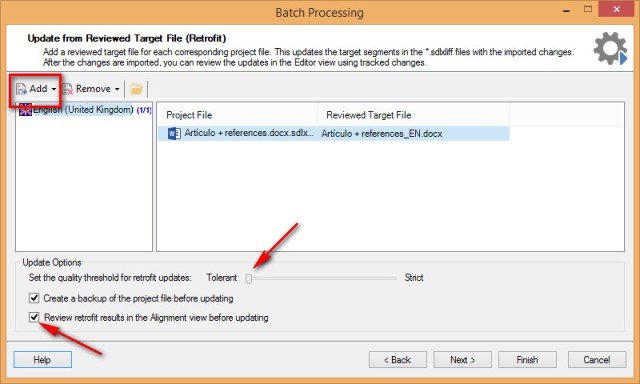
- Set the sliding scale to define whether Studio should be tolerant of changes (all – or nearly all – changes will be pulled in, but the alignment might not be good) or strict (Studio will only implement clear-cut changes where alignment looks straightforward. Use when only a few simple changes have been made). I recommend sliding the marker towards tolerant and then reviewing the file in the Alignment view before importing the changes.
- Enable Create a backup of the project file before updating.
- Enable Review the reverse alignment before updating.
- Check alignment and adjust if necessary.
- Click Update SDLXLIFF file.
- In the Editor window, Studio will mark all imported changes as tracked changes and segment status will be Translation Rejected. Filter segments by unconfirmed to see all the changes.
- Accept the track changes one by one in the Editor or all at once.

- Update your TM by confirming the edited segments or by running the Update Main Translation Memories batch task.
- The SDLXLIFF can’t contain comments, track changes or TQAs (see below) for Retrofit to work.
- Retrofit processes all segments, regardless of their status.
- Target segments can’t be empty. Retrofit will work, but segments will be misaligned. Solution: copy source to target before performing Retrofit.
- Locked segments can obviously be edited in the native file format. Retrofit will import these changes back into the locked segments. (This could be good or bad news, depending on why the segment is locked.)
- You don’t need to accept track changes in the reviewed file before performing Retrofit.
- Comments in the reviewed file need to be removed before importing because they are added as separate segments and spoil the alignment.
Ribbon customisation
You can now customise the Quick Access Toolbar and the Ribbon itself.
To customise the ribbon, go to the View tab > Ribbon Customization > Customize Ribbon.
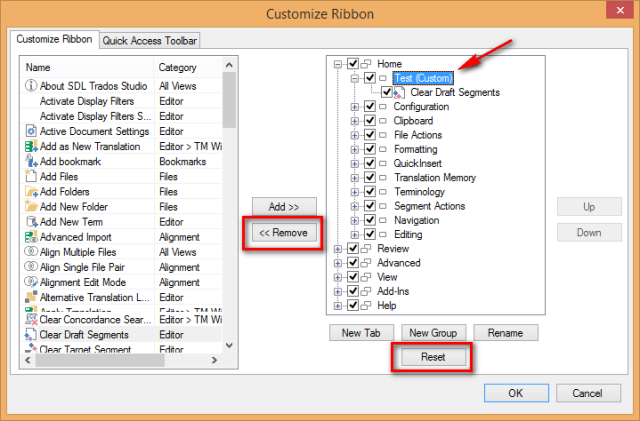
Ribbon tips:
- You can create new tabs, which can contain any groups and icons you like.
- New groups within existing tabs will be added at the far left. Icons are context sensitive so you won’t be able to add some icons to some groups.
- The word custom in brackets at the end of a new group name won’t be displayed in the Ribbon itself.
- If you make a change but can’t see the result, try closing and opening Studio again.
- Hide unwanted icons by unticking their boxes, or remove them completely with the remove button (in the case of custom-added icons and groups).
- Use reset to return to default settings.

However, I find keyboard shortcuts far quicker than clicking on icons, so I haven’t made any changes to the Ribbon itself. Also, bear in mind that if you ever ask for help or give help yourself, you’ll speak the same language as the other person if you share the same ribbon.
I’m disappointed I can’t copy the Display Filter group on the Review tab to the Home tab. That would have been nice. I’ll have to stick to my Ctrl+F6 shortcut after all.
New user interface
New interfaces are always controversial. Comments flew back and forth on the beta forum as developers fine-tuned the interface in response to testers’ feedback. I found the bare white background very cold to begin with; the icons looked faint and hard to decipher. But the more familiar the new interface became, the more clunky and garish Studio 2014 seemed. Take, for example, the difference in the draft and confirmed statuses in Studio 2014 and 2015. I much prefer the stylish pencils of 2015 to the chunky crayons of 2014:
Compare the bright colours of 2014

with the clarity of 2105 (click on the images to enlarge them for a fairer comparison):

You can change the white background by going to the View tab > Color Scheme but the choice there is a looming storm (dark gray) or a cloudy day (light gray). Maybe the Color Theme Plugin on the Open Exchange will be updated soon to work with Studio 2015.
My take on the new user interface. I love it! (Does anyone else remember switching from the blue background of Word Perfect to the blank white page of Word many years ago, and wondering if you’d ever get used to it?)
Translation Quality Assessment
Translation Quality Assessment (TQA) is a new feature in Studio 2015 Professional that provides a method to calculate the quality of a translation by assigning points to categories such as errors, omissions, grammar, spelling and formatting.
As I’m not a project manager I haven’t explored this new feature, but you can read more about it on this page of the Studio Help files.
New .docx file type
This new file type for Microsoft Word 2007-2016 is a work in progress. The default file type in Studio 2015 is still Microsoft Word 2007-2013.
To test the new file type, go to the File tab > Options >File Types and tick the box next to its name. Then move it up in the list to give it priority, or disable the old .docx file type. The screenshot below shows default settings, before enabling the new file type.

An interesting new option under Common (in the File Types list on the left) is inline tag handling when an error is thrown saving the target file. This makes Studio less fussy about minor tag issues when saving.
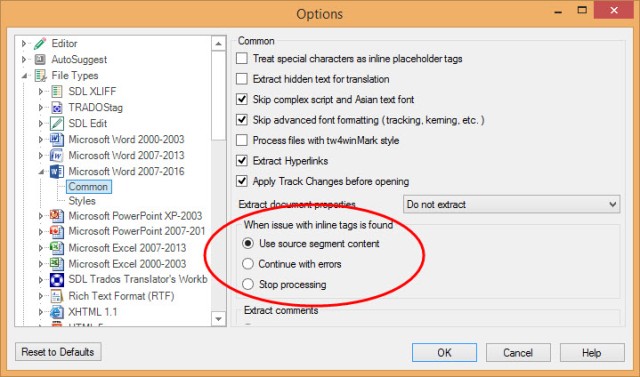
Hopefully, in its final version, the new file type will be able to deliver the real-time Word preview that Office Click-to-Run users have been sorely missing for several years now.
Miscellaneous
Term recognition limit solved
Pre-2015, Studio didn’t recognise terms from a termbase in segments that exceeded 250 characters. This limit has now been lifted. Studio 2015 marks terms with a red bracket right through to the end of segments, up to a maximum of 1024 characters.
Option to exclude locked segments from analysis
You can now ignore locked segments in an analysis, which is useful if files have been processed in Studio and certain segments have been locked. To re-run the analysis, go to your target language file view, right click the file(s) and select analysis. In the analysis wizard, check the box below:
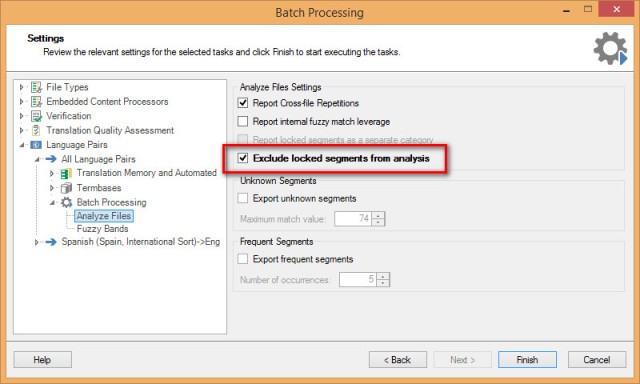
Add as new translation
If you want to add an alternative translation for a segment that has already been translated in your TM, you used to have to go to the Advanced tab. This option has now been moved to the drop-down list of confirm options on the Home tab:

Word counts and hyphens
After listening to users’ feedback on the way Studio 2014 SP2 handling of hyphens affected the word count, SDL has now given us the chance to decide how Studio 2015 counts hyphenated words. To change this setting:
- Go to the Translation Memories view and select your TM. Go to Home tab > Settings > Fields and Settings > Count as one if words.
- Then, go to Performance and Tuning and re-index your TM for the new settings to take effect.
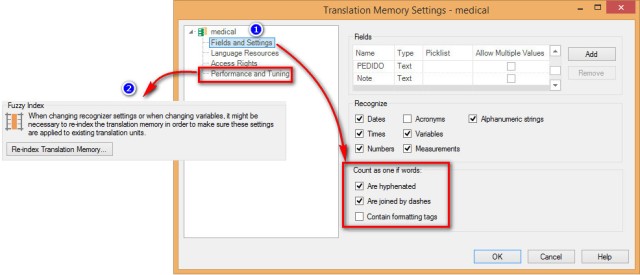

No comments:
Post a Comment